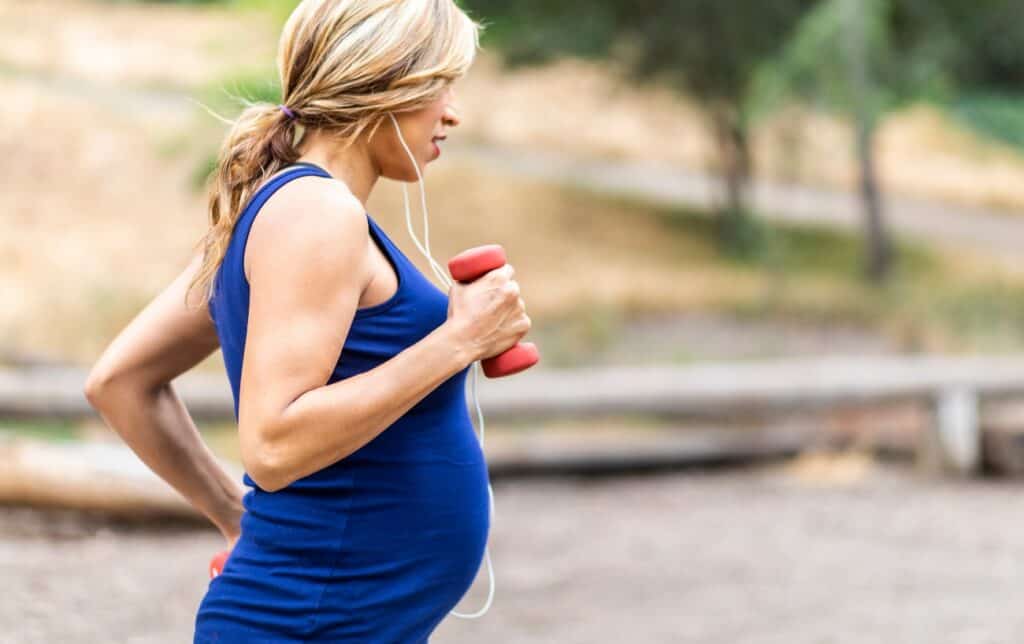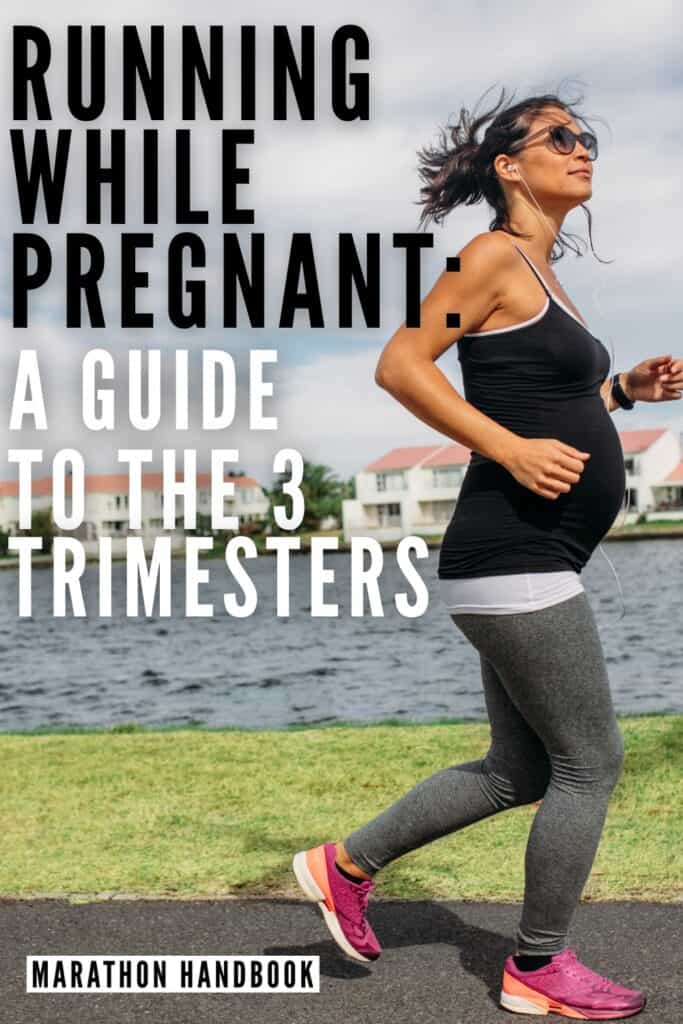Running while pregnant used to be something that was mostly seen with only elite female runners.
However, as the body of research1Beetham, K. S., Giles, C., Noetel, M., Clifton, V., Jones, J. C., & Naughton, G. (2019). The effects of vigorous intensity exercise in the third trimester of pregnancy: a systematic review and meta-analysis. BMC Pregnancy and Childbirth, 19(1). https://doi.org/10.1186/s12884-019-2441-1 regarding the physical and mental health benefits of exercise during pregnancy—and specifically the safety of running during pregnancy—has grown, many everyday recreational runners are now running through their second trimester and even third trimester of pregnancy.
This isn’t to say that there aren’t challenges with maintaining an exercise routine that includes running while pregnant.
Still, for many women runners who have a healthy pregnancy, it can absolutely be possible to run while pregnant.
To learn more about the physical and mental health benefits of running while pregnant and how to safely run through each trimester of pregnancy, Marathon Handbook collaborated with midwife and prenatal run coach Acadia Gantz of Canyon Wren Coaching to put together this guest article about running while pregnant.

Is It Safe to Run During Pregnancy?
Despite previously held beliefs about exercise in pregnancy, we now know that exercise, including running, is not only safe . . . but beneficial!
Exercise in pregnancy has numerous benefits for your developing baby including lowering your chance of preeclampsia, gestational diabetes, and preterm delivery.
We also know that running makes us feel good! It reduces the risk of pregnancy-related anxiety, depression, and body image concerns related to weight gain and your growing belly.
The American College of Obstetricians and Gynecologists (ACOG)2The American College of Obstetricians and Gynecologists. (2019, July). Exercise During Pregnancy. Www.acog.org. https://www.acog.org/womens-health/faqs/exercise-during-pregnancy currently recommends that women with low-risk pregnancies should get 150 minutes of moderate-intensity aerobic exercise per week.
These are the same physical activity recommendations set forth by the Centers for Disease Control and Prevention (CDC)3Centers for Disease Control and Prevention. (2022). How Much Physical Activity do Adults Need? Centers for Disease Control and Prevention. for all adults, which means that the pre-pregnancy, pregnancy, and postpartum periods of your life can and should include about 30 minutes of moderate intensity cardiovascular exercise most days of the week.
Moreover, if you were running prior to getting pregnant, you should be able to continue running as long as you don’t have pregnancy complications or specific contraindications that your OB-GYN discusses with you.
In fact, studies4Kuhrt, K., Harmon, M., Hezelgrave, N. L., Seed, P. T., & Shennan, A. H. (2018). Is recreational running associated with earlier delivery and lower birth weight in women who continue to run during pregnancy? An international retrospective cohort study of running habits of 1293 female runners during pregnancy. BMJ Open Sport & Exercise Medicine, 4(1), e000296. https://doi.org/10.1136/bmjsem-2017-000296 suggest that running while pregnant may actually increase the chance of vaginal delivery vs cesarean section and does not lead to low birth weight or preterm labor.
But remember: pregnancy is unlike any other time in your life.
Many changes are taking place, and not just physically.
There are mental, emotional, work, and relationship shifts happening as well, and all of these can affect not just your running goals, but also your daily running habits.
Therefore, as with all types of physical activity, it is important to discuss running during pregnancy with your OB-GYN or other healthcare provider to make sure it is safe for you and your baby.

Running During The First Trimester
Here are the top three topics that come up when working with running during the first trimester of pregnancy:
1. Will I Overheat Running While Pregnant?
You may hear concerns about an increased core body temperature causing pregnancy complications such as neural tube defects in the baby.
Overheating is particularly a concern in the first trimester.
However, your core body temperature would need to exceed 102 degrees Fahrenheit for this to become a concern.
You are unlikely to reach this core body temperature simply from exercising unless you are doing very strenuous exercise on a hot day.5Study challenges overheating risk for pregnant women exercising in the heat. (n.d.). The University of Sydney. Retrieved March 14, 2024, from https://www.sydney.edu.au/news-opinion/news/2021/07/16/study-challenges-overheating-risk-for-pregnant-women-exercising-.html
However, it is still smart to avoid running in the heat of the day.
You should wear loose-fitting clothing, stay well hydrated, and stop or slow down if you begin feeling overheated, short of breath, or lightheaded.
Note: Using a sauna or a hot tub should absolutely be avoided during pregnancy.
2. How Do I Deal With Morning Sickness Running?
For many pregnant women, the first trimester is a time of nausea, vomiting, and extreme fatigue.
While exercise can help with some of these symptoms, it is important to respect your body’s needs during this time.
Figure out what time of the day you feel best and plan your workouts for when you have the most energy and the least amount of nausea.
Be sure to eat a healthy, high-protein snack first thing in the morning (having a high-protein snack right before bed or in the middle of the night can also help with nausea!).

A handful of nuts, a cheese stick, a low-sugar protein bar, or a piece of fruit with nut butter are all good morning snack options.
If possible, try to eat something before you even sit up in the morning.
Hydration is also super important; consider sipping sports drinks instead of plain water if you are nauseous.
Try making a simple lemonade by mixing a pinch of salt, and a splash of lemon juice and maple syrup into your water. Not only will this be easier to absorb by your body, but it also provides electrolytes.
Carry a small, easy-to-digest snack, and water, on all runs, and sneak a few ginger or peppermint candies into your pocket or sports bra in case nausea strikes on the run!
3. How Can I Run If I’m So Tired?
Do not feel guilty for choosing to nap instead of going for a run, your body is busy making a human and you need rest!
A good rule of thumb is to lace up your running shoes, get out the door, and commit to running or walking as a warm-up for 10 minutes.
If you still feel exhausted, go home and nap.
If you feel energized, then continue your run or walk.
Intervals with running and walking are also a great choice for running while pregnant in the first trimester when your energy levels are much lower than normal.
Focus on effort level or heart rate to guide your workouts rather than worrying about pace.
Avoid caffeine or other stimulants, as they can affect the placental blood flow and potentially restrict your baby’s growth. (One small cup of coffee or tea a day is ok.)
Running During The Second Trimester – 3 Things To Consider

1. Consider Your Nutritional Needs
Your nutritional needs grow as the baby grows.
Most pregnant women need an additional 300 calories during the second and third trimesters.
However, this is not an excuse to pile on the ice cream!
Choosing healthy and nutritious foods is even more important in pregnancy to promote your own health and well-being as well as that of your baby.
Pregnant runners need to be even more mindful of fueling before and after running, and eating at regular intervals throughout the day.
Focus on a balance of protein, fresh fruits and vegetables, and healthy fats.
(Of course, the occasional treat is important, too, but try to avoid eating high-sugar right before bed to prevent blood sugar spikes overnight.)
2. Take Advantage Of Feeling Better
Many pregnant people refer to the second trimester as the “honeymoon phase” or as their favorite part of pregnancy.
For many people, nausea and vomiting have subsided and energy levels are much higher than in the first trimester.
And while your baby bump may be noticeable, it is not as big as it will be in the third trimester as you get closer to your due date.
This means that you might not yet have the lower back pain, pelvic pain, pelvic floor pressure, and chest pain due to the extra weight and pressure in the abdomen and the enlargement of the breasts that many pregnant women experience in the third trimester once your baby is getting closer to their birth weight.
If this “honeymoon phase” applies to you, take advantage of feeling good running during the second trimester of pregnancy.

If you want to run in a race during pregnancy, now is a good time to find one, or simply enjoy the way it feels to run with your baby on board.
If you do plan on running a race while pregnant, remember that even in a competitive setting, it is important to respect your body and your baby and not push past feeling good.
3. Be Aware of the Effects Of The Relaxation Hormone On Your Body
As your pregnancy progresses past the first trimester and into the second trimester, your body starts producing more of the hormone relaxin.
Relaxin6Pregnancy and pelvic floor health. (n.d.). Mayo Clinic Health System. https://www.mayoclinichealthsystem.org/hometown-health/speaking-of-health/pregnancy-and-pelvic-floor-health#:~:text=The%20placenta%20secretes%20the%20hormone is aptly named as it helps your joints and ligaments around the hips and pelvis, as well as the cervix, “relax” in preparation for birth.
Relaxin can increase the risk of pelvic floor pain and general instability in the hips and pelvis, and even other joints in the body.
It is important to pay attention to your posture and avoid overstretching your muscles and joints, particularly if your exercise program includes activities such as strength training and yoga.
While you should still cool down after your running workouts, make sure that you are not pushing the range of motion on any post-run stretching you might do.
Relaxin is also responsible for GI distress that can appear in pregnancy such as constipation, diarrhea, and heartburn. Your midwife or doctor should have suggestions to help relieve some of these uncomfortable pregnancy side effects.
Running During The Third Trimester – 3 Things To Consider

1. Your Body Feels So Different!
The third trimester is when your belly has really “popped.”
Some runners find the growing belly to be exciting and others can find it uncomfortable both mentally and physically.
It is important to acknowledge all your feelings about your changing body and know that they are all valid!
As your uterus and growing baby are getting bigger, your blood volume is also expanding, and your breasts are changing in preparation for breastfeeding.
Here, a helpful tip for running during pregnancy is to wear a belly band and get a more supportive sports bra to provide extra compression and support against excessive bouncing with the impact of running.
2. Why Is Running Hard In the Third Trimester?
All of the changes your body is going through can lead to you feeling heavier and slower, and that running is suddenly much harder, and that’s totally normal and totally ok!
Your body may no longer be up to vigorous intensity exercise during the third trimester, even if your fitness level is still great.
Plus, many pregnant women, even healthy pregnant runners, are more prone to high blood pressure during the third trimester, and your center of gravity changes with each passing week as your baby is rapidly growing.
For these reasons, the third trimester is a great time to shift toward more walking or walk/run intervals.
Continuing to get outside and move your body–even if it is less running than you were during the first and second trimesters–has the same health benefits for you and your baby without the increased stress on your body.
Swimming, Tai Chi, low-intensity elliptical machine workouts, deep water running or walking, and prenatal yoga are also great options for third-trimester exercise.
3. Use Running to Prepare for Birth
Have you ever heard of birth being compared to a marathon?
Well, there is a reason for that!
Giving birth takes mental and physical strength and resilience, and who would be better prepared for that than a runner?!
Not only does running while pregnant give you the physical strength and stamina for giving birth, but it’s also a great time to practice positive self-talk, pick your favorite birth mantras, meditate, or make a relaxing playlist.
As a bonus, the snacks you use to fuel long runs are also the best type of snacks to have on hand for labor!

Running While Pregnant – Advice from Our Pregnancy Running Expert, Acadia:
Running during pregnancy is generally regarded as a safe activity for people with a low-risk pregnancy.
However, pregnancy is not a time to push past your body’s early warning signals.
Take your pregnancy one day at a time and don’t get discouraged if there are days that you don’t feel like running, switch to a walk, or go home and nap and try again the next day.
Moving your body in any way that feels good has great benefits for you and your growing baby.
After your little one has been welcomed to the world and you receive the clearance to start to exercise, check out our tips for postpartum running here!














I spoke with my ob-gyn and they said as long as I’ve been running all my life, it’s perfectly fine to continue to do so. That was about the extent of it. Thank you so much, this is such great information.
-Leeleesana Carneiro